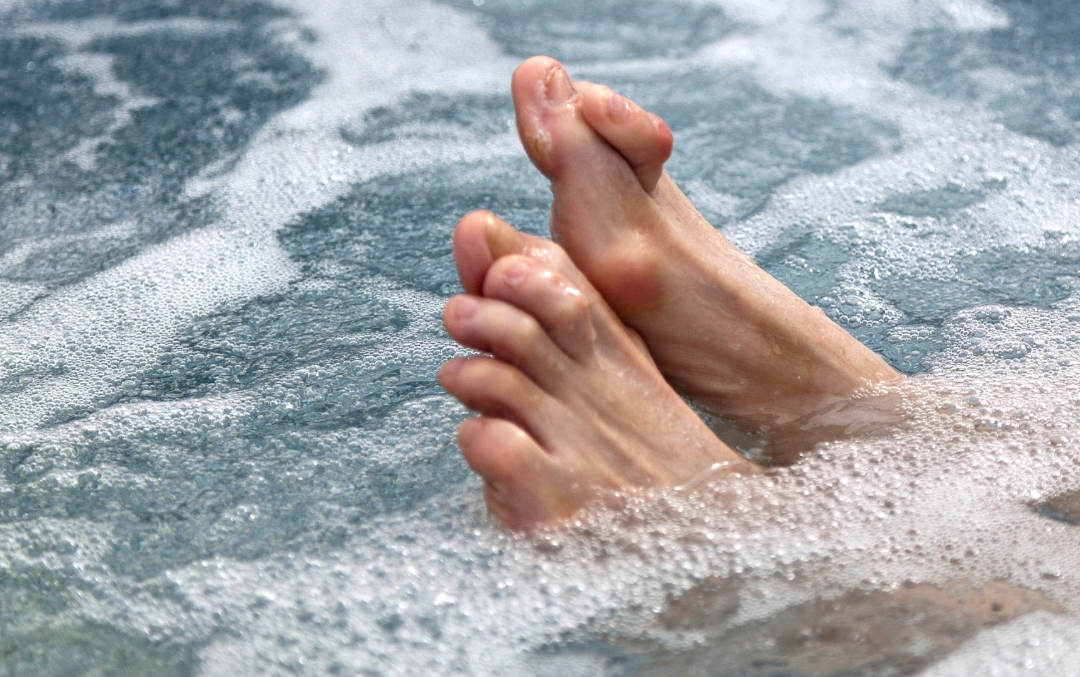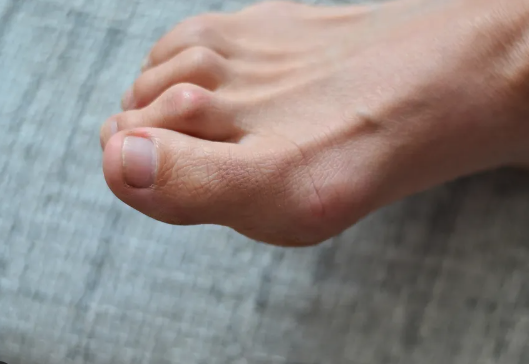
Jump to section
Noticing your toes curling and changing shape can become a real problem - whether the changes are causing you pain and discomfort when
wearing shoes, or you’re not keen to have your toes displayed for all to see during the warmer months. Either way, you’re in the
right place with our experienced Brisbane podiatrists.
Hammer toes are a type of lesser toe deformity, affecting the normal alignment of the toes other than your big toe, which puts you at risk
of pains and other problems. Each of the lesser toes contain three bones (phalanges) connected to one another and to the ball of the foot by
joint capsules. There are also many muscles, ligaments and tissues that attach to the toes and contribute to both their function (like when
you curl your toes downwards or point your toes upwards), as well the healthy movement of the foot as a whole.
A hammer toe appears like an upside down ‘V’ shape in the affected toe(s), presenting when the toe bone closest to the ball of the foot extends upwards, and the middle bone points back downwards, with the last toe maintaining a relatively neutral position, as illustrated here. Hammertoes often affect the second toe and can occur alongside bunions.
Hammer toes are not something you are born with, but instead develop over time. The most common causes or contributing factors to hammer toes include:
A person may also have a greater genetic predisposition to developing hammer toes through certain structural and functional foot characteristics being passed down through families.

The biggest symptom of a hammer toe is the hammer-like position the toe is left in. This may start off as flexible, meaning that the toe can be straightened by hand, but can grow to become rigid over time. While the changes to the joints of a hammer toe may not necessarily be painful in and of their own, they can be disruptive to a person’s gait through the changes in foot biomechanics, can make it difficult to wear shoes comfortably or even find shoes that fit the forefoot, and can result in corns, calluses or blisters developing on the toes that can cause much pain and discomfort if special care is not taken.
Our podiatrists can clearly and confidently diagnose a hammer toe deformity from a physical examination in our clinic. From here, we’ll be able to discuss your symptoms, treatment options and prognosis.
When hammer toes are left untreated, they may lead to pain and discomfort when walking or wearing shoes, the development of corns, calluses, blisters and other pains - and even balance issues if multiple toes are severely affected. As hammer toes tend to progressively worsen, it is likely that your hammer toes will continue to worsen over time and grow stiffer, which can cause additional pains.
Managing your hammer toes starts with a podiatric exam to assess the position, integrity, flexibility and strength of the toes, joints and
muscles. From here, we’ll discuss the likely causes of the changes you’re experiencing in your toes, and discuss the most
suitable treatment options that will support you in getting the best outcome, whether that is helping slow or stop the progression of the
deformity or manage any associated pains and problems. This may include:
While most hammer toe deformities don’t require surgery, if your toes are fixed in place and are causing you considerable pain or discomfort, we may discuss whether a referral to an orthopedic surgeon is right for you so you can discuss your surgical options.
If you’ve just noticed changes to the position of the joints in your feet, the first thing to review is your footwear as this plays a
large role in hammer toe development for many people, especially if your shoes feel tight, have a narrow forefoot, or are high-heeled.
Knowing that these shoes are likely contributing to the problem, the best thing you can do is switch to shoes that have a spacious toe box,
do not exceed a heel height of 40mm, and do not feel tight, even with thick socks for the cooler months. The earlier you can make these
footwear changes, the better.
If your joints still have good flexibility, you can try exercises to support the strength and flexibility of the toes. This includes gently straightening the toes to bring them into a natural position and holding for several seconds, feeling a long, slow and gentle pull. You can also try towel curls, where you use your toes to crumple a towel that is placed flat beneath your feet, and use your feet to pick up marbles on the floor and drop them into a cup.
Is hammer toe a form of arthritis?
No hammer toes are not a form of arthritis, but a person who has inflammatory arthritis such as rheumatoid arthritis may be more prone to developing hammer toes.
Can a podiatrist fix a hammer toe?
There is a lot that podiatrists can do to help manage your pain and discomfort, and control the other symptoms of hammer toes, helping to stop or slow their progression. Given the nature of hammer toes, however, if ‘fixing’ a hammer toe means achieving a straight toe position, then any medical professional will be limited in their options aside from surgery.
What kind of shoes are best for hammer toes?
Choose shoes that are comfortable and supportive:
| Monday | 7:40am - 6:00pm |
| Tuesday | 7:40am - 6:00pm |
| Wednesday | 7:40am - 6:00pm |
| Thursday |
7:40am - 6:00pm |
| Friday | TEMP CLOSED |
| Saturday | CLOSED |
| Sunday | CLOSED |
Ground Floor, 344 Queen Street,
Brisbane City QLD 4000
| Monday | 7:40am - 6:00pm |
| Tuesday | 7:40am - 6:00pm |
| Wednesday | 7:40am - 6:00pm |
| Thursday |
7:40am - 6:30pm |
| Friday | 7:40am - 5:00pm |
| Saturday | 7:40am - 4:30pm |
| Sunday | CLOSED |
Newmarket Village, 114/400 Newmarket Rd, Newmarket QLD 4051